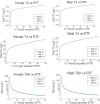Restoration of euthyroidism with levothyroxine: implications of etiology of hypothyroidism and the degree of residual endogenous thyroid function
- PMID: 35966075
- PMCID: PMC9363917
- DOI: 10.3389/fendo.2022.934003
Restoration of euthyroidism with levothyroxine: implications of etiology of hypothyroidism and the degree of residual endogenous thyroid function
Abstract
There are many thyroid-related factors that combine with non-thyroid-related factors in order to affect the patient response to treatment of hypothyroidism, in terms of their satisfaction with therapy. Some of the thyroid-derived factors include the etiology of the hypothyroidism and the amount of residual thyroid function that the patient retains. These two factors may be intertwined and affected by a third influence, the presence of thyroid peroxidase antibodies. The downstream consequences of the interactions between these three factors may influence both free thyroxine and free triiodothyronine levels, TSH concentrations, and various thyroid biomarkers. Evidence of the widespread importance of thyroid hormones can be inferred from the multiple genes that are regulated, with their regulation affecting multiple serum biomarkers. Thyroid biomarkers may extend from various well-known serum markers such as lipids and sex hormone-binding globulin to serum levels of thyroid hormone metabolites. Moreover, the interplay between thyroid hormones and biomarkers and their relative ratios may be different depending on the hypothyroidism etiology and degree of residual thyroid function. The ultimate significance of these relationships and their effect on determining patient-reported outcomes, quality of life, and patient satisfaction is, as yet, poorly understood. However, identification of better biomarkers of thyroid function would advance the field. These biomarkers could be studied and correlated with patient-reported outcomes in future prospective studies comparing the impact of various thyroid hormone therapies.
Keywords: biomarkers; etiology; patient satisfaction; quality of life; residual thyroid function; thyroid hormones.
Copyright © 2022 Jonklaas.
Conflict of interest statement
The author declares that the research was conducted in the absence of any commercial or financial relationships that could be construed as a potential conflict of interest. The reviewer ACB is currently organizing a Research Topic with the author.
Figures



Comment in
-
Editorial: (Re)defining hypothyroidism: the key to patient-centered treatment.Front Endocrinol (Lausanne). 2024 Feb 6;15:1369723. doi: 10.3389/fendo.2024.1369723. eCollection 2024. Front Endocrinol (Lausanne). 2024. PMID: 38379867 Free PMC article. No abstract available.
Similar articles
-
Levothyroxine Monotherapy: What Works Better for the Individual With Hypothyroidism?Endocr Pract. 2023 Jul;29(7):572-580. doi: 10.1016/j.eprac.2022.12.013. Endocr Pract. 2023. PMID: 37419564 Review.
-
Are We Restoring Thyroid Hormone Signaling in Levothyroxine-Treated Patients With Residual Symptoms of Hypothyroidism?Endocr Pract. 2023 Jul;29(7):581-588. doi: 10.1016/j.eprac.2023.04.003. Endocr Pract. 2023. PMID: 37419565 Free PMC article. Review.
-
Redefinition of Successful Treatment of Patients With Hypothyroidism. Is TSH the Best Biomarker of Euthyroidism?Front Endocrinol (Lausanne). 2022 Jun 16;13:920854. doi: 10.3389/fendo.2022.920854. eCollection 2022. Front Endocrinol (Lausanne). 2022. PMID: 35784560 Free PMC article. Review.
-
Biologic blood markers reflecting thyroid hormone effect at peripheral tissue level in patients receiving levothyroxine replacement for hypothyroidism.Acta Med Hung. 1991;48(1-2):33-43. Acta Med Hung. 1991. PMID: 1813856
-
The History and Future of Treatment of Hypothyroidism.Ann Intern Med. 2016 Jan 5;164(1):50-6. doi: 10.7326/M15-1799. Ann Intern Med. 2016. PMID: 26747302 Free PMC article.
Cited by
-
Impaired autonomic function and somatosensory disturbance in patients with treated autoimmune thyroiditis.Sci Rep. 2024 May 29;14(1):12358. doi: 10.1038/s41598-024-63158-w. Sci Rep. 2024. PMID: 38811750 Free PMC article.
-
MYOFIBROBLASTS HINDER RECOVERY OF HASHIMOTO THYROIDITIS IN THE ULTRASTRUCTURAL LEVEL.Acta Endocrinol (Buchar). 2023 Oct-Dec;19(4):415-420. doi: 10.4183/aeb.2023.415. Epub 2024 Jun 24. Acta Endocrinol (Buchar). 2023. PMID: 38933253 Free PMC article.
-
Psychological factors and obesity, not thyroid biomarkers, predict thyroid-dependent quality of life in treated hypothyroidism: a cross-sectional study.BMC Endocr Disord. 2025 May 26;25(1):136. doi: 10.1186/s12902-025-01962-9. BMC Endocr Disord. 2025. PMID: 40420021 Free PMC article.
-
Thyroid disorders and gastrointestinal dysmotility: an old association.Front Physiol. 2024 May 2;15:1389113. doi: 10.3389/fphys.2024.1389113. eCollection 2024. Front Physiol. 2024. PMID: 38803365 Free PMC article. Review.
-
Quality of life, daily functioning, and symptoms in hypothyroid patients on thyroid replacement therapy: A Dutch survey.J Clin Transl Endocrinol. 2024 Feb 2;35:100330. doi: 10.1016/j.jcte.2024.100330. eCollection 2024 Mar. J Clin Transl Endocrinol. 2024. PMID: 38357535 Free PMC article.
References
-
- Hollowell JG, Staehling NW, Flanders WD, Hannon WH, Gunter EW, Spencer CA, et al. . T(4), and thyroid antibodies in the united states population (1988 to 1994): National health and nutrition examination survey (NHANES III). J Clin Endocrinol Metab (2002) 87(2):489–99. doi: 10.1210/jcem.87.2.8182 - DOI - PubMed
-
- Ito M, Miyauchi A, Morita S, Kudo T, Nishihara E, Kihara M, et al. . TSH-suppressive doses of levothyroxine are required to achieve preoperative native serum triiodothyronine levels in patients who have undergone total thyroidectomy. Eur J Endocrinol (2012) 167(3):373–8. doi: 10.1530/EJE-11-1029 - DOI - PubMed
Publication types
MeSH terms
Substances
Grants and funding
LinkOut - more resources
Full Text Sources
Medical

